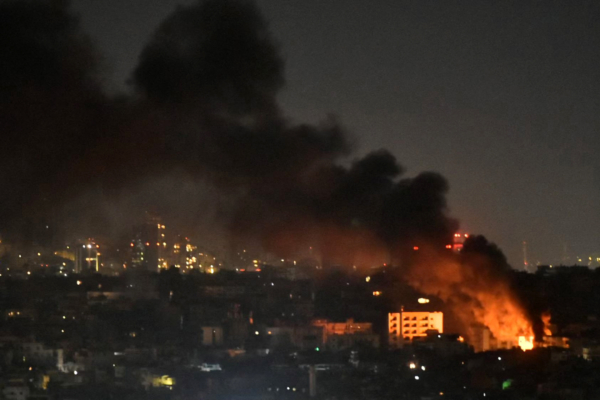On Sunday evening (October 20), multiple explosions were heard in various parts of the Lebanese capital Beirut, prompting hundreds of residents to flee their homes. Prior to this, Israel had announced its intention to target locations in Beirut associated with the financial activities of Hezbollah, urging people to immediately evacuate these areas.
Witnesses told Reuters that Beirut had experienced at least 10 explosions. The National News Agency of Lebanon indicated that the southern part of Beirut was hit by 11 airstrikes, with many targets belonging to Hezbollah’s “Al-Qard Al-Hassan Association,” a financial institution recognized by the United States as managing Hezbollah’s finances in Lebanon, with over 30 branches, 15 of which are located in densely populated areas in downtown Beirut and its suburbs.
The “Al-Qard Al-Hassan Association” has been accused by Israel of paying operatives of Iran-backed radical organizations and assisting in the purchase of weapons.
One of the strikes reportedly occurred near Beirut Airport. A reporter from Agence France-Presse confirmed that commercial planes were seen landing through the smoke after the airstrikes, indicating that the airport was still operational and unaffected.
Witnesses informed Reuters that a building in the residential area of Chiyah in southern Beirut was reduced to rubble by the blast. Thankfully, the area had been evacuated before the explosion and no casualties were reported.
People attempting to flee the airstrikes were said to have caused traffic chaos in some areas of Beirut.
Earlier, an Israeli military spokesperson posted on the social media platform, saying that Israel would begin attacking the infrastructure of Hezbollah’s “Al-Qard Al-Hassan Association” and warned people to stay away.
Neither the “Al-Qard Al-Hassan Association,” Hezbollah, nor the Lebanese government immediately commented on the attacks.
When asked whether these financial institutions could be considered military targets, a senior Israeli intelligence official told the press that the purpose of the attacks was to undermine Hezbollah’s economic operations during wartime, as well as its ability to rebuild and re-arm post-war.
A year ago, Hezbollah began launching rockets into Israel to support Hamas in Gaza. Since then, the two sides have engaged in cross-border skirmishes.
In early October, Israel launched a ground incursion into Lebanese territory.
Following the killing of Hamas leader Yahya Sinwar a few days ago, Israel intensified its military operations in Gaza and Lebanon, bringing hope for an end to over a year of conflict.
With the upcoming U.S. election, officials, diplomats, and other sources in the region indicate that Israel aims to protect its borders through military actions to prevent adversaries from regrouping.
Israel is also preparing to retaliate against Iran’s missile attacks earlier this month.
Earlier on Sunday, Israel reported hitting Hezbollah’s intelligence headquarters and an underground weapons factory in Beirut.
The Israeli military claimed that three Hezbollah commanders were targeted and eliminated.
Hezbollah did not immediately comment on these attacks but stated that they had launched missiles at Israeli military positions inside Lebanon and a base in northern Israel.
The Israeli Defense Forces confirmed that Hezbollah had fired approximately 200 rockets into northern Israel.
During Sunday’s battle in northern Gaza, a 41-year-old Israeli colonel was killed, and another officer was injured. Israeli media reported that an explosive device detonated under a tank at the time.
According to the Gaza Health Ministry, the Israeli attack on Beit Lahiya on Saturday resulted in 87 fatalities or missing persons, marking one of the highest death tolls in a single strike in months.
As tensions escalate, the U.S. THAAD missile defense system is now deployed in Israel to protect against potential Iranian aggression.
Around 100 U.S. soldiers are expected to operate the system, which serves as a complement to the Patriot system, capable of defending a wider area and targeting objects within a range of 150 to 200 kilometers.

